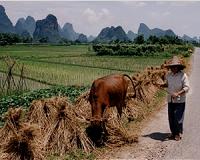| . |  |
. |
Edmonton, Canada (SPX) May 18, 2011 With an increasingly warmer climate, there is a trend for springs to arrive earlier and summers to be hotter. Since spring and summer are the prime growing seasons for plants-when flowers bloom and trees increase in girth and height-do these climate changes mean greater seasonal growth for plants? This is a critical question for forest management, especially in the boreal region-an area particularly sensitive to the effects of climate change. Dr. Jian-Guo Huang, currently a post-doc at the University of Alberta, and colleagues from the University of Quebec at Montreal were interested in assessing whether a potentially extended growing season affects stem xylem formation and growth in black spruce (Picea mariana) in Western Quebec, Canada. They published their findings in the May issue of the American Journal of Botany. Xylem cells conduct water and nutrients from roots to the leaves, but also provide mechanical support and form the wood of trees. Growth patterns of xylem are of interest to foresters because thicker-walled xylem cells produce denser wood-and aspects of the climate, such as temperature and rainfall, may impact not only the number of cells produced during a growing season, but also cell wall thickness. By taking microcore samples from black spruce trees at three different latitudes ranging from 47.5o to 50oN in Western Quebec throughout the growing season (May-September) in 2005 and 2006, Huang and colleagues were able to determine when xylem cell production began and ended, as well as the pattern of xylem cell growth. They then compared these data to soil and air temperature and precipitation data gathered from local climate stations. "Every small wood xylem cell contains meteorological information during its growing process," Huang commented. "Exploring a series of micro-wood xylem cells helps us understand the macro-climate variability." When the authors examined the pattern of xylem cell initiation, they found an interesting correlation with patterns in air temperatures in the two years. Across all three sites, xylem cell production in black spruce trees started earlier in 2006 than in 2005, corresponding with an earlier spring (and warmer May temperatures) in 2006-indicating a positive relationship between temperature and onset of xylem production. Temperature affects not only when cells begin to grow, but also the growth patterns of those cells. Xylem cells produced early in the season-earlywood-are large in size with thin walls, while those produced later in the season-latewood-are smaller and have thicker walls. Despite early warm temperatures in 2006, temperatures for the rest of the growing season were actually lower in June through August compared with 2005. And, correspondingly, Huang and co-authors found that in 2006 black spruce trees stopped producing both early and latewood earlier than in 2005. Consequently there were higher ratios of latewood cells to total xylem cells in 2006, and narrower, less-productive growth rings. "Our study implies that despite the expected occurrence of earlier phenological development due to early spring climate warming, boreal trees like Picea mariana might not be producing wider rings if cold temperatures occur later in the growing season in June to August," Huang said. "These results may challenge the view that boreal trees could be benefiting from spring warming to enhance growth." Thus, not only is the timing of the onset of spring important, but the amplitude of summer warming temperatures also plays a role in wood production. Huang and his colleagues intend to further explore how intra-annual xylem formation of other boreal species, particularly broadleaf species, is responding to climate warming and varies across species and sites. "Because broadleaf species are more limited by precipitation, early spring warming (i.e., early onset of cell production) followed by cold June-August temperatures (i.e., less drought stress) might favor xylem cell production, resulting in wider rings and better growth, when compared with conifers like Picea mariana," commented Huang. "These different growth responses to climate warming across species might lead to potential changes in forest growth, structure and composition, as well as the whole forest ecosystem productivity, and carbon equilibrium." Jian-Guo Huang, Yves Bergeron, Lihong Zhai, and Bernhard Denneler (2011). Variation in intra-annual radial growth (xylem formation) of Picea mariana (Pinaceae) along a latitudinal gradient in western Quebec, Canada. American Journal of Botany 98(5): 792-800. DOI: 10.3732/ajb.1000074.
Share This Article With Planet Earth
Related Links American Journal of Botany Forestry News - Global and Local News, Science and Application
 Reforesting rural lands in China pays big dividends
Reforesting rural lands in China pays big dividendsStanford CA (SPX) May 13, 2011 An innovative program to encourage sustainable farming in rural China has helped restore eroded forestland while producing economic gains for many farmers, according to a new study by Stanford University researchers. Their findings are published in the Proceedings of the National Academy of Sciences (PNAS). "The Sloping Land Conversion Program, which began in 2000 after massive flood ... read more |
|
| The content herein, unless otherwise known to be public domain, are Copyright 1995-2010 - SpaceDaily. AFP and UPI Wire Stories are copyright Agence France-Presse and United Press International. ESA Portal Reports are copyright European Space Agency. All NASA sourced material is public domain. Additional copyrights may apply in whole or part to other bona fide parties. Advertising does not imply endorsement,agreement or approval of any opinions, statements or information provided by SpaceDaily on any Web page published or hosted by SpaceDaily. Privacy Statement |